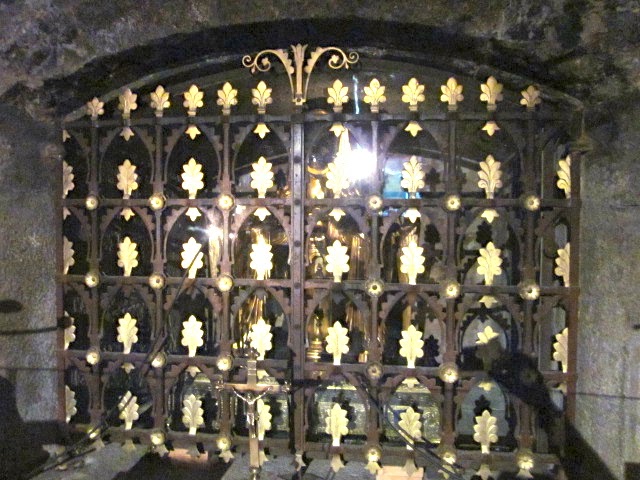According to The Golden Legend, Mary Magdelene, Mary Jacobus and Mary Salome,
(the three Marys at the empty tomb of the risen Jesus) Lazarus and Martha (the brother and sister of Mary Magdelene), and a steward of their house, Maximinus,
were cast off from Holy Land by Roman persecutors in 42 a.d.
They were ushered into a fragile boat that had neither rudder nor sail,
with the intention that they would drown, however, they landed at what is now
Saintes-Maries-de-la-Mer, at the mouth of the Rhone, just west of Marseilles.
Upon arrival, Mary
Magdelene converted all of Provence to Christianity then wandered in the mountains of Sainte Baume for thirty
years and lived a solitary life of penance and prayer in a cave.
On the day before her death she descended to find Maximinus
in order to receive Communion and discuss her funeral arrangements. Legend also has it that she was born aloft to Aix in the arms of angels to receive viaticum, the Holy Eucharist, as part of the last rites.
There was (is) some dispute as to where her bones lie. *
According to Western, i.e not the Eastern Orthodox tradition,
from about 1050 Mary's relics were venerated at the Abbey of La Madaleine in Vezelay, Burgundy. Allegedly they had been moved from Sainte Maximin in 771 to protect them from the invading Saracens. However in 1279, during an excavation ordered by Charles II, King of Naples, her shrine was discovered with an inscription explaining why the Magdalene's relics had been thus hidden.
Charles built a basilica on the site and in exchange for providing lodging for pilgrims,
the town's people were exempt from paying taxes.
A contemporary, the Dominican
Bernard Gui, chronicled miracles which further
supported the argument that these were genuine relics.
He wrote that a
sweet spicy fragrance emanated from the sarcophagus' contents,
and that
a green shoot was found to be growing from Mary Magdalene's tongue.
Behind the gilt and bronze gates is the reliquary which contains a piece of Mary's
forehead where Jesus touched her after he rose from the dead and said the Aramaic equivalent of "Noli me tangere"
(touch me not).
Noli Me Tangere by Alanso Cano mid 17th C
Adjacent to her reliquary is a 3rd Century marble sarcophagus
carved in low relief with various scenes, including what is considered to be the oldest known depiction of the Nativity. It contains all the ingredients of a Christmas card:
wise men bearing gifts, a manger with a swaddled baby overlooked by a cow and donkey,
a star over the stable and a bemused young woman sitting with her legs crossed.
Carved into the soft plaster, a large area of wall was "tagged" by hundreds of years' worth of visitors.
I'm not yet certain what the horseshoe shaped forms represent. If they are indeed horseshoes
they could be there to bring more good luck to those at sea for they were often
used on boats as well as on land. They could also be something akin to the Masonic Arch.
I will find out more next time I visit.
In the
gift shop, the man behind the counter was struggling with his mobile phone.
He
tapped and sighed, tapped and sighed until a tinny ringtone chirped
gaily.
Surprised by his unexpected success he
Surprised by his unexpected success he
fumbled the phone up into the air and down onto his desk
whereupon the battery flew out
and slid across the floor. I picked it up and handed it to him with my postcards
and smiled the look which said in the universal language
"Don't worry, I'm complete a luldite too".
* Relics tend to be dispersed far and wide as they are a desirable object of veneration and good relics will attract pilgrims. I bump into bits of Mary Magdelene as well as other notables, like St. John the Baptist, here and there in my travels. There are bits of Mary in Cyprus, Constantinople, and Florence, to name but a few places.







No comments:
Post a Comment